The Science of
Temple Kumbhabhishekam
Kumbhabhishekam is the pinnacle ritual of Temple consecration. The
process is really a group of specific rituals prescribed by the
Agama Shastras for the purification and consecration of a sacred space.
The Agamas are the main texts which deal with the details of Temple
construction, consecration, and worship. “Kumbha” means a water pot.
“Abhishekam” is the ritual of pouring consecrated water over the images
and Temple towers (Gopurams and Vimanam) in order to purify
and energize them.

Abhsishekam in Sanskrit can mean “empowering,” “anointing,” “bathing,” “consecrating,” or “coronating.” This is the conclusion of many days of rituals during which Holy water, which has been blessed through multiple fire ceremonies and other rituals, is poured from water pots onto the sacred images in the Temple and over the inverted kumbhas atop the Temple towers. Through these rituals the Temple is purified of all negative energies that would hinder its sanctity and the Temple is energized. This process opens channels to the inner realms through which thousands of Devas can gain easier access to the physical realm in order to bless and assist people in all realms of life.
Kumbhabhishekam performed for new Temples and images is called Nutana kumbhabhishekam. For new Temples and images, additional rituals are necessary to achieve the preliminary purification of the space and materials and consecrate the image, and to establish the flow of spiritual energies between realms. The Devas dwell in the inner realm. We cannot easily see them or speak to them. It is also difficult for them to see into the physical realm and to communicate with us. The rituals of Temple consecration help to open channels for the Devas to gain great access to help, heal, and bless the people. It is during the initial kumbhabhishekam of a Temple in which the images are consecrated and installed that Prana Pratishtha rituals are conducted. Prana Pratistha is the “life-giving ceremony” that establishes the lifeforce of God in the image and transforms a mere stone (called bimba in Sanskrit) to a sacred icon. These consecrated images are called murtis or vigrahas in Sanskrit and they are given special reverence and respect. Once these rituals of Prana Pratistha have been performed, regular puja offerings must be made daily in accordance with the scriptures.
It has become popular in English to translate the word vigraha as “idol.” This is a habit that we should get away from. Idol is a word introduced by Christian missionaries who desired to insult and weaken the Hindu tradition. The word “Idol” along with the concept of “idolatry” or “idol worship” has many negative connotations including the false belief that the Lord is the image used for worship. We should use the Sanskrit words murti or vigraha instead, or if we must choose an English equivalent, the word “Icon” is a much more respectable word that denotes the sacred nature of the consecrated images without the negative connotations associated with terms like “Idol.” Temple vigrahas are not thought to be God, as God is in all that is. Temple images incorporate certain symbolic elements that have a certain uplifting effect upon the unconscious mind. They are used as a point of focus for people’s prayers and worship. The physical stones and images do get imbued with powerful spiritual vibrations which can be felt by those who are perceptive. They are sacred in nature and treated as a manifestation of God himself, but they are not believed to be God. God is understood to be transcendent and also to pervade the entire creation. It is said “Prema iva shivamaya satyam eva parashivah” which means “God is immanent Love, pervading everything in creation; and God is transcendent Truth, beyond all manifest things.f

Once the initial rituals to energize a Temple have been completed, it is considered necessary to re-consecrate the Temple every 12 years. This time period is how long a Temple will generally be able to maintain its sanctity before it begins to diminish. This time is also the general lifespan of the all natural herbal mortar, called ashta bandhanam, used to attach the vigrahas to stone peethams (pedestals) in the Temple. The ashta bandhanam will begin to wear out after 12 years necessitating its replacement. At this time other necessary renovations are evaluated and completed before the Temple is reconsecrated. It is understood that major repairs or renovations to a temple will disturb the energies in the space and possibly the sanctity of the Temple. For this reason, renovations are carried out just before kumbhabhishekam rituals are to be conducted.
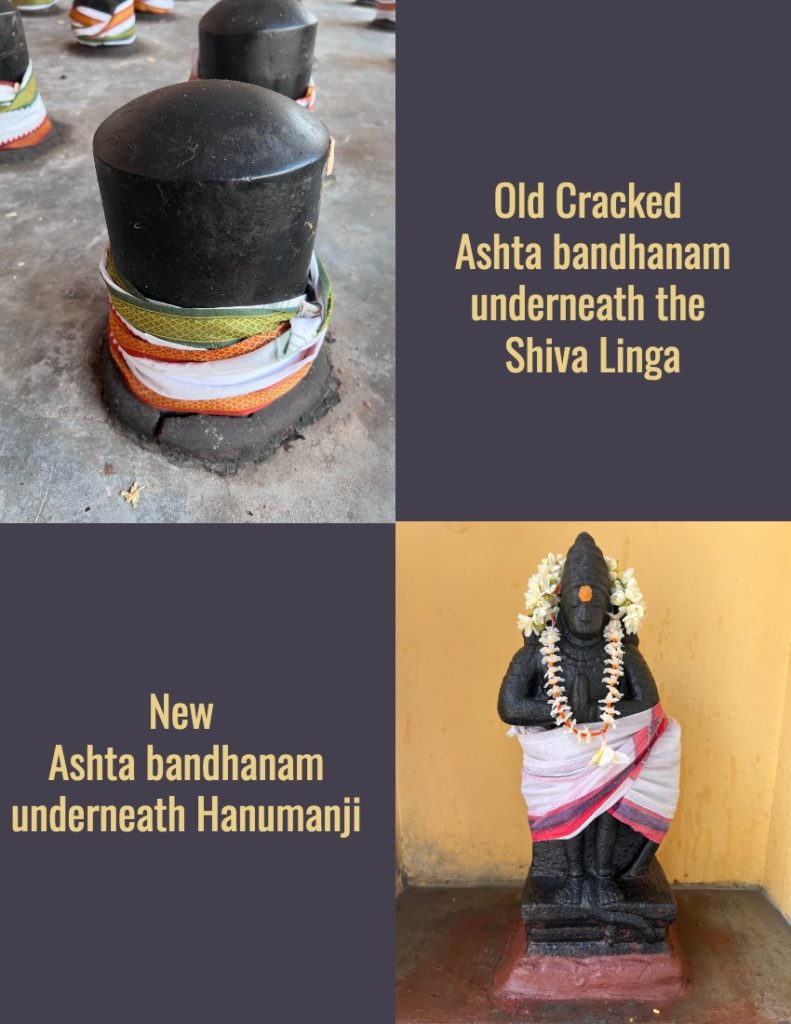
There are various reasons a Temple may require these rituals sooner than the standard 12 years. When kumbhabhishekam is done to purify and re-energize Temples and icons in general, it is called jeernoddharana kumbhabhishekam. According to the Agamas, there are four types of jeernoddharana Kumbhabhishekam:
- Anavardhana – new construction – these ceremonies are necessary whenever new deities or temple towers or mandapams (halls) are added to an existing Temple.
2. Punaravardhana – Reestablishment of an abandoned Temple – Repairs are conducted, and rituals to atone for the neglect and to reestablish the sanctity of the Temple are conducted.
3. Aavardhana – Repair or renovation after wear and tear due to time – Every 12 years, a Temple is checked before kumbhabhishekam and necessary repairs are completed. In certain cases, serious deterioration of the structure may require immediate repairs to happen sooner than 12 years, after which kumbhabhishekam is conducted.
4. Andharitham – restoring the sanctity of a temple disturbed by natural and unnatural forces – There are various inauspicious events which may disturb the sanctity of a Temple. These include flooding from unprecedented rains, or damages from storms, landslides or lightning to the Temple structure, theft or vandalism or arson, military attacks or massacres inside the temple compound, the death of a person or large animal inside the Temple, or certain cases even when an animal enters the Temple unexpectedly. There are certain inauspicious events that can irreversibly corrode a Temple’s sanctity also, at which point the Temple must be deconsecrated and abandoned or relocated.
The Temple itself is designed carefully with many considerations in mind and consecrated at every step of its construction from acquiring the land, to laying the foundation and placing doorways and pillars, to the installation of Deities, flag pole, bali peethams, and the completion of temple Towers. The Temple itself is designed in alignment with the body and the astrology of its founder. The size of the founder’s body creates a unit of measurement which is used to size every detail of the Temple. The nakshatra of the Temple’s founder will determine the direction of the door and other features in the Temple’s design. The size and shape of the Temple property is considered when choosing the size for the Vigrahas. Everything is in proportion with the human body and the space of the property itself. It is said that “deho devaalayah proktah jiivo devah sanaatanah” “The body is a Temple, and the embodied Soul is in essence God eternal.” Vastu (the sacred science of space) sees a dwelling as an extension of the body. The sacred Temple is also seen as a microcosm of the macrocosm of the Universe. Within the mystical form of the sacred Temple is the body of its human founder, but also the whole of creation.
The Temple is built in the form of the human body and various parts of the Temple relate to specific parts of the human body. The Garbha grihyam (the sanctum sanctorum, where the Virgraha is installed) is likened to the human face. When we see a person, we recognize them by their face. It is in the grabha grihya where we have darshan (sight) of the Lord. This is where the Devas see and bless the devotees also. The eyes to see on the human body are located on the face. Vimanams are smaller Temple towers generally located directly above the garbha grihyams. These are likened to the nose on the face. This makes sense structurally because the nose is the greatest extension on the human face. This also makes sense mystically because the purpose of the vimanam is to help attract various Devas to the sanctum below so that they can bless the people through the offerings made within. This is similar to how a person may sniff out a desired object using the nose.
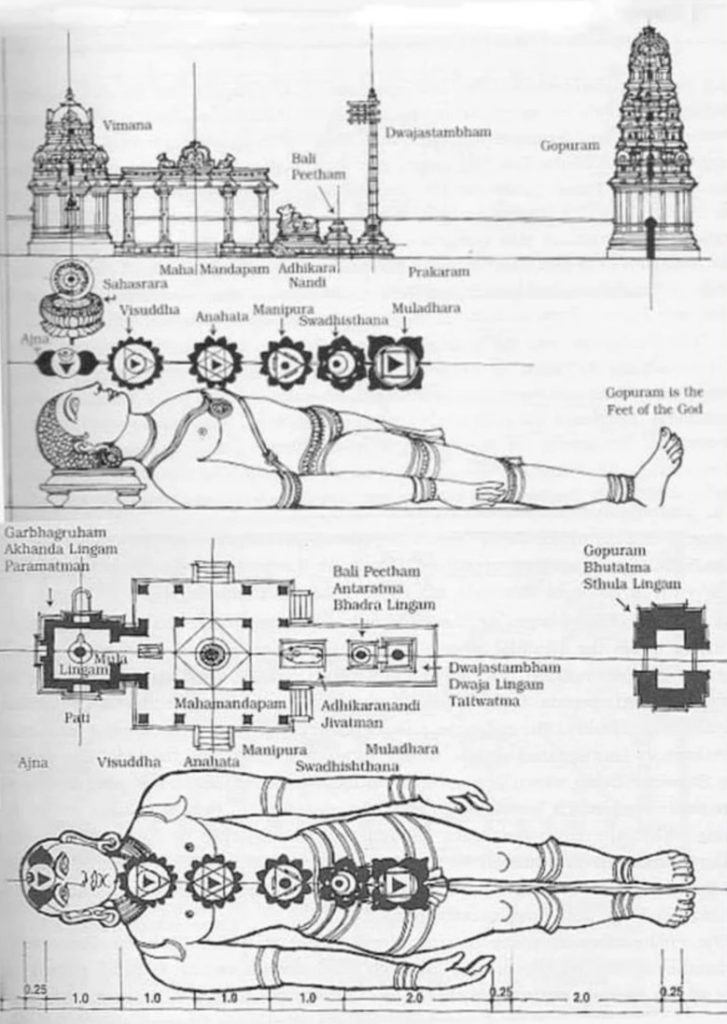

Many vimanams are gilt in gold, which has a mystical property of helping to open a window into the physical realm for the Devas to see more easily. Large deposits of gold in Temple sanctums are said to shine for many kilometers in the inner realm attracting the Devas from afar to come and assist with Temple pujas. The ardha mandapam (half-hall in front of the sanctum) represents the neck. The Maha Mandapam (large hall) represents the chest. The vahana (vehicle) of the Deity, positioned in front of the bali peetham and in a direct line to the garbha grihyam where the Deity sits, can be like the heart. The vehicle of each Deity represents love for and devotion to the Divine, and the specific animals related to each Deity represent the qualities needed to approach that particular aspect of Divinity. If we are like a bull, persistent and fearless in our Sadana, for example, we reach Shiva.
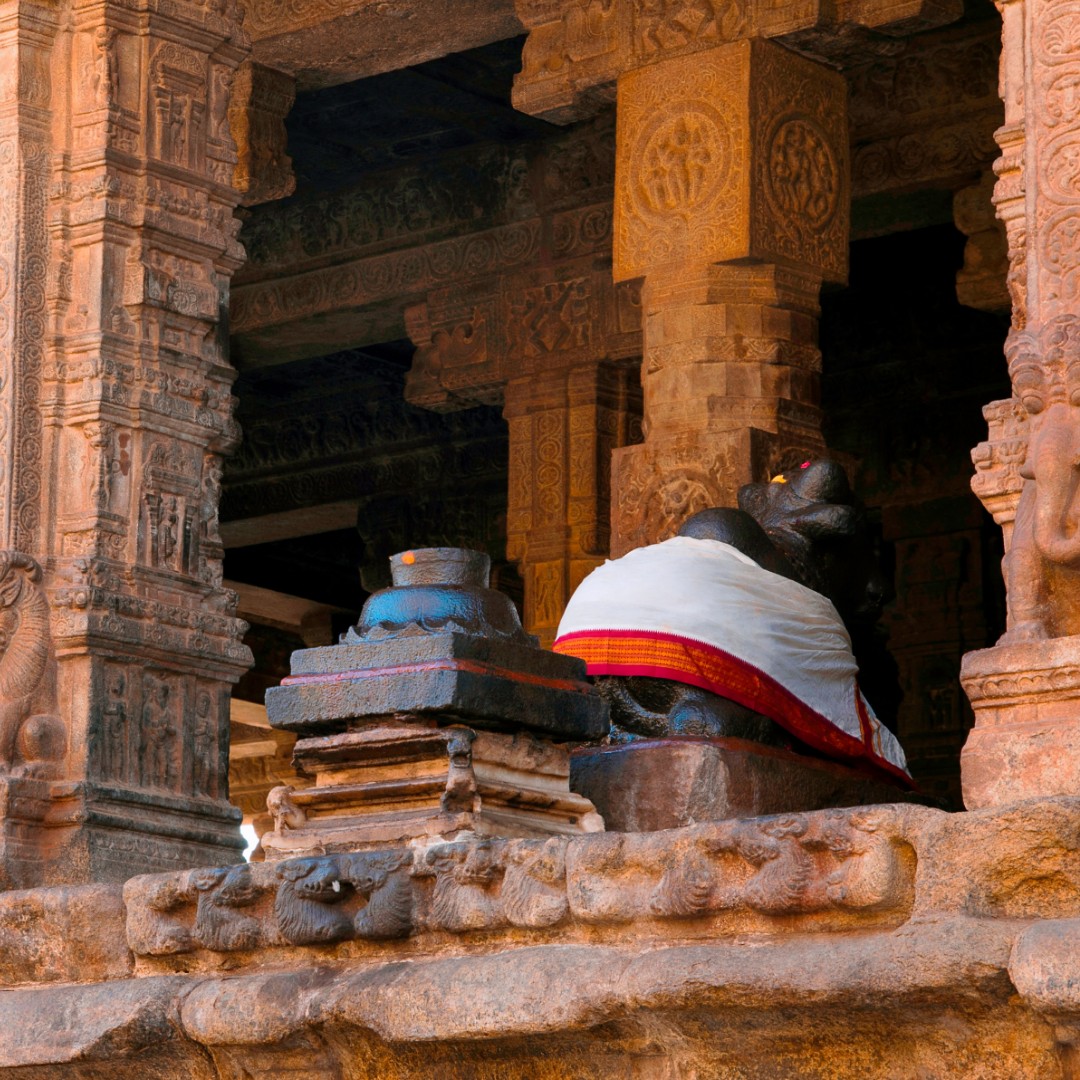

The Bali peetham represents the stomach. It is here that offerings of rice are made to remove negative energies from the Temple. Spiritual beings which may otherwise disturb the sanctity of the Temple are satiated by such offerings. The dwajasthamba (flag pole) represents the jeevadhara, the life generating power. Temple flagpoles are often gilt in gold and they are instrumental in signaling to the Devas the location of the Temple so they can come to bless the people. During special festival times, flags are hung on the flagpoles to signal to local people that it is a time of special spiritual significance and that special celebrations are occurring through which great blessings can be obtained for those who attend with faith. The flagpole is also said to be like the human spine. The spine supports the body and carries impulses from the nerves to the brain and throughout the body. The spine also is where the subtle sushumna nadi is located which is activated when the kundalini is awakened in deep states of meditation.
The flag pole serves as a conductor to help to ensure energies are flowing properly through the Temple so that the blessings from the sanctum are being sent to the Temple towers and from these to the surrounding community. The flag pole also helps gather and ensure that negative energies throughout the Temple are dispersed at the bali peetham. It is generally kept in close proximity to the bali peetham to help facilitate this important role.
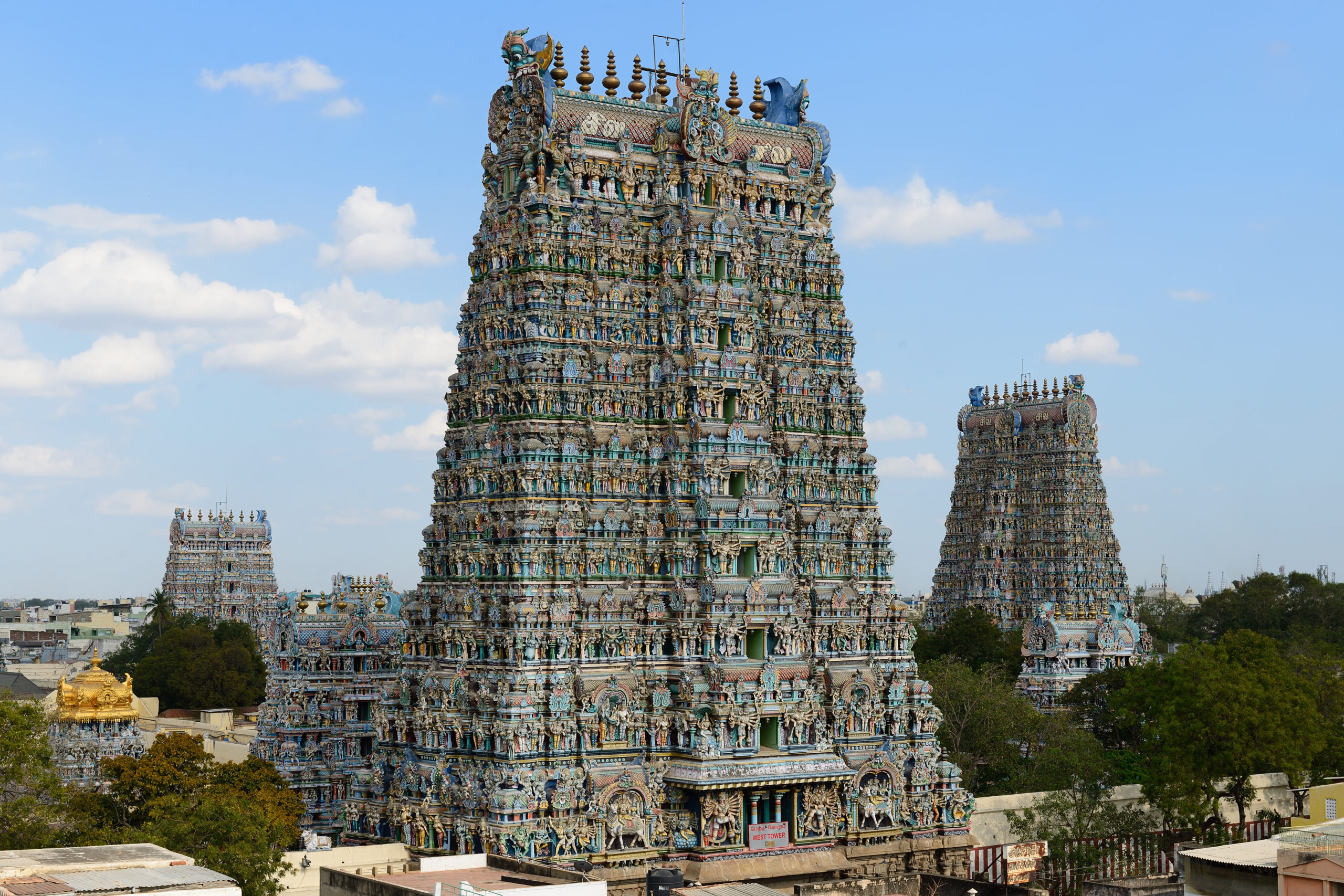
The Raja Gopuram, the large Temple tower is said to relate to the feet. The feet are said to be a place from which a great deal of energy leaves the human body. This is why we do not touch people with our feet out of respect but why we seek to touch the feet of Holy people. Much negative energy leaves through the feet of an average person, but many blessings are transmitted through the feet of a Holy person. Devotees rush forward to touch the feet of Temple priests after big ceremonies have been completed also. Much positive energy has been generated through hours of Vedic recitation and so the devotees touch the priest’s feet with devotion to receive some of this energy. The Raja gopuram along the prakara (compound wall) of the Temple is the furthest point from the garbha grihya, even as the feet are the furthest from the head in the body. The function of the Raja Gopuram is also significant in this analogy. The Temple towers serve to send the Lord’s blessings to the surrounding area. A properly consecrated Gopuram is capable of sending the spiritual energies for over a hundred and fifty miles (around 90 km) to the surrounding area. This is one important reason Hindus always try to live in close proximity to a Temple, so that they can be within the energetic field of the Temple’s blessings. The prakaras (compound walls) around the Temple are said to relate to the five senses. Simpler Temples may only have one wall, but the elaborate Temples have a series of walls, often five or more. The soul is bound and limited by the 5 senses and our knowledge of the outer world is gained through the five senses.. The Temple is protected from intruders and wild animals and its boundary is clearly defined by the prakara.
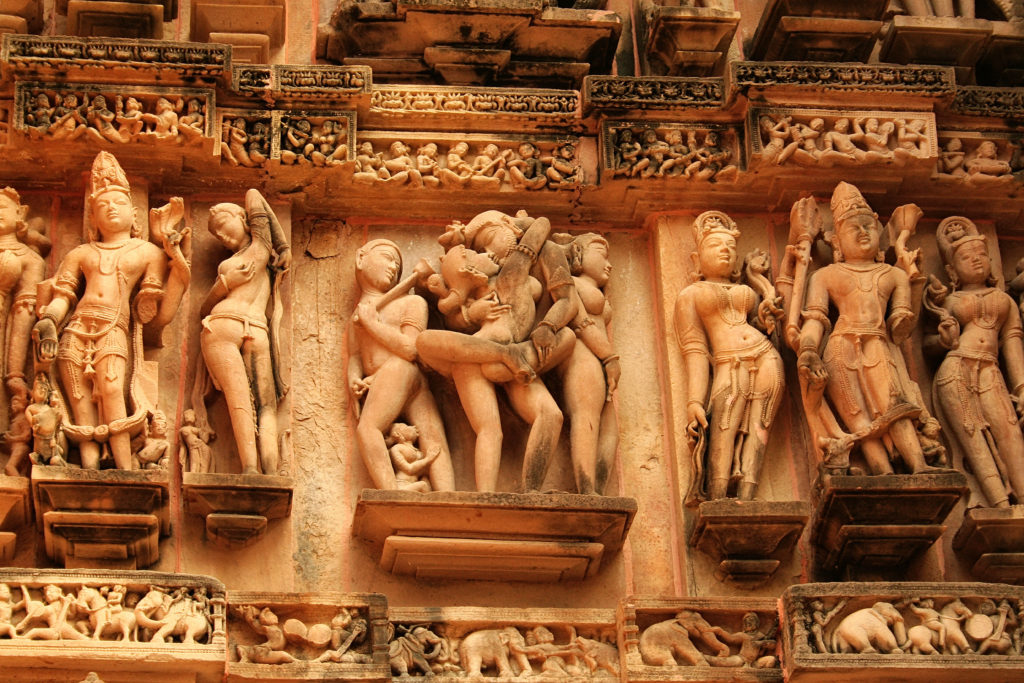
The process of entering the Temple is thought to represent the spiritual journey within oneself. On the outer walls, ornamentation is complex and elaborate. It appears quite chaotic. It often depicts busy scenes of worldly existence. Images of violence and even sexual images are not uncommon here. This represents the chaotic existence of the embodied soul caught in Maya and swayed by desire and the five senses. As we progress further into the Temple, we begin to see images of the Gods and Goddesses. Many depictions are there of stories from the scriptures which teach us the lessons needed to live a happy life and to come to spiritual realization. This represents the movement from worldly consciousness to spiritual consciousness, when a person stops living simply seeking pleasure, but begins to study the scriptures and realize the importance of living a dharmic life and seeking something higher.
As we move toward the center of the Temple, ornamentation becomes progressively less colorful and ornate. The garbha grihyam where the deity is housed is usually very plain and most often one solid color. This is a stark contrast to the colorful and elaborately decorated Temple towers. This structure is called a sannidhi. Sannidhi means “vicinity” or “proximity” in Sanskrit. It is at this central location in the Temple that devotees have darshan (sight of the Deity). Spiritual experiences tend to occur here and blessings are generated from this sacred spot. Yet Temple sannidhis tend to lack elaborate ornamentation as not to distract from the inner experience of templer devotees. This architectural simplicity also represents the mind becoming more still as the subconscious is purified through yoga and meditation. It also becomes darker as one travels from the open air deep into the inner mandapams and sanctum of the Temple. This represents the process of meditation which leads to realization, in which we must first face the darkness of the lower self before we can see the light of the higher Self, which is one with God. As we close the physical eyes to meditate, we gain spiritual vision.
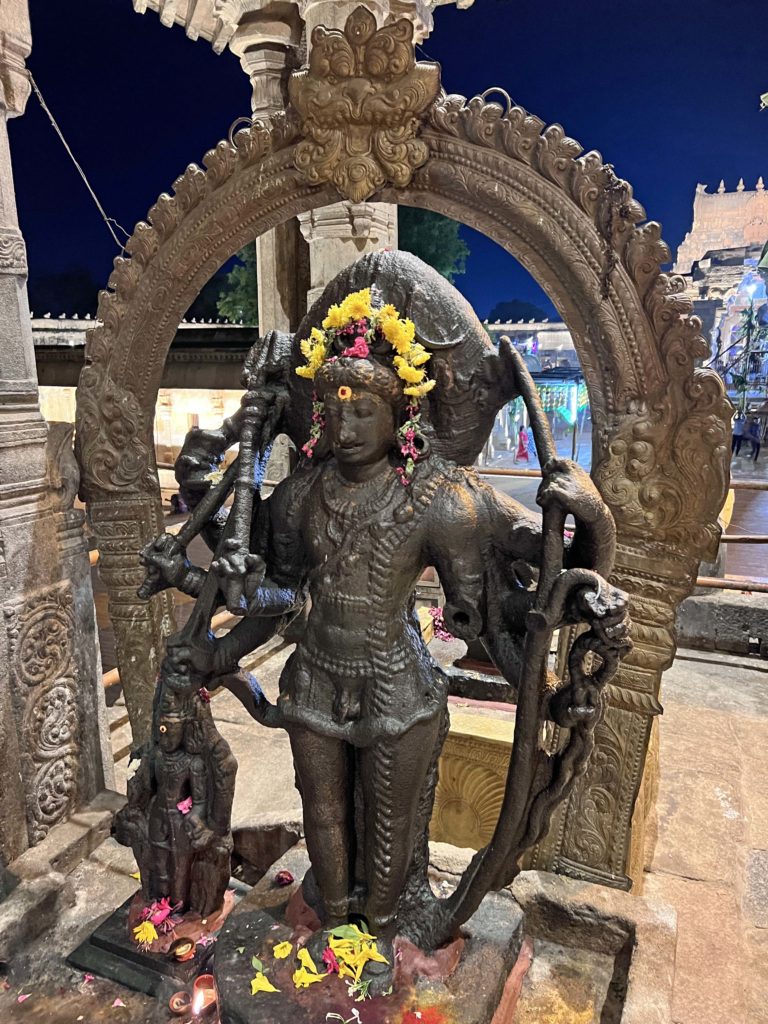
The Vigraha of the Deity itself is usually plain black granite in South India. In the design of the Temple, there are also certain depictions of demonic beings. Around the Vigrahas, there are often metal thiruvachis or arches. These thiruvachis have yakshas and makaras (two fearsome spiritual beings) depicted on them. Such demonic beings are also depicted on the nasis throughout the Temple. Nasis are horseshoe-shaped niches that decorate Temple towers and structures. This reminds us that God is in all: in the worldly and ego-driven actions of people; and also in Divine beings; and also in demonic beings. This also warns us of the dark forces and beings we may encounter as our spiritual perception increases. This also forewarns of the darkness we must see in ourselves before we can see the light of the Divine.

The consecration of a Temple is a grand event that requires the participation of hundreds of people including numerous well-trained Vedic Purohits (priests). The ceremonies involve many elaborate offerings which are expensive to procure and laborious to prepare. It is definitely a community effort. Everything must be planned according to the scriptures and timed carefully by a competent astrologer. For new images being installed for the first time, special rituals are required to purify and bring life to the image, turning stone (bimba) into the living, breathing manifestation of God (Vigraha). The crucial ritual is Prana Pratishtha, meaning “establishment” (pratishtha) of “life” or “breath” (prana). God is the Breath of the breath and all things that live live by His grace. This ceremony invokes God into the image where Divine prana is established for the benefit of society. Channels are opened into the inner realms so that blessings can pour forth into the physical realm and the shakti (power) of God comes to dwell in the image. The Vigraha is not believed to be God, but a point of focus for the prayer and meditation of the people. It does get imbued with sacred power and is treated with great reverence for the energy it holds and its role to maintain a channel to connect the realms.
Newly carved images are cleaned with various substances including mud from the Ganges or other Holy rivers, cow dung, crushed bananas, ash, and tamarind 32 times in a ritual called “murti samskara.” Coconuts, ash gourds and limes may be broken by the dozens or hundreds to remove drishti (negative energy transferred through glance) from Temple Icons or from Temple structures. New images are purified energetically through a ceremony called “bimba shudhi.” The Pancha Gavya (five sacred substances from the cow: milk, ghee, yogurt, dung, and urine) are consecrated with mantras and blessed in a homam called Brahma Kurcha, where the Panchagavyas are offered with a bundle of darbha grass with particular Vedic mantras. The duly consecrated Panchagavyas are then used to bathe the statue, which is then washed again with rice flour and warm water. These rituals help to remove dirt and dust from the physical image and they remove the negative energies of the carvers (shilpi dosha) or others who have handled or transported the statues.
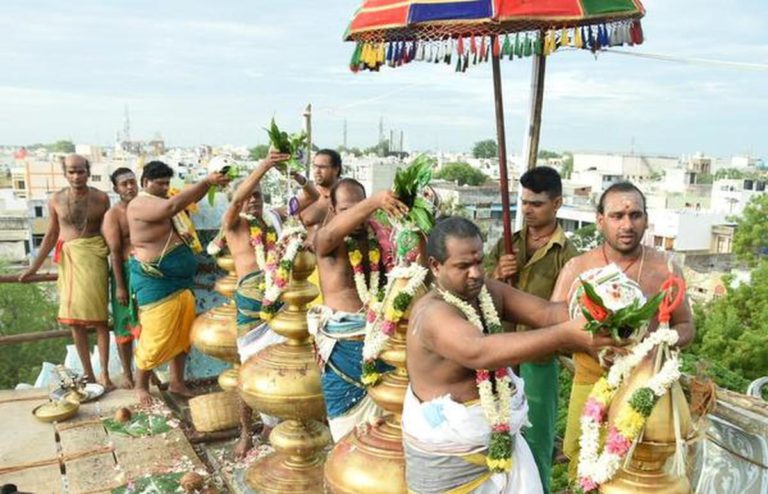
It is not until the Temple is being consecrated that the carving is completed. The pupils of the eyes are left unfinished until the time of consecration. The eyes are then ceremoniously carved in a ceremony called Netra Unmeelanam (or eye opening). Homam is performed to empower this process and offerings are made with ghee and honey along with special herbs and netronmeelanam mantras. This consecrated ghee and honey is then taken to the newly carved eyes of the image along with Vedic mantras to facilitate the eye-opening. A special rod made of gold with a diamond tip is used for this. Gold and diamonds both have properties to open channels for the Devas to see into the physical realm. Sometimes anjanam (collyrium) is made with special herbs along with the ash from the homam and this is applied to the eyes of the image also. This process is conducted with the Deity screened from the view of onlookers present.
Upon completion, before people are allowed to see the deity, ten special items are shown to the Lord. These are known as the Dasha Darshanam (ten things to be seen). These things are shown to the Devas and not the other way around. Sometimes the list of ten items varies. It may include animals, items, or people. Common items include elephants, cow and baby cow (presented after go puja is performed), mirror, gold, scriptures, a Saint, a Sannyasi (renunciate), a kanya (a young girl), a Sumangali (a married woman), a raja (a king). Each of these has great mystical significance which is beyond the scope of the present article. Lights are kept dim during these ceremonies and only natural ghee lamps are used. When the screen is removed, it is symbolic of spiritual sight which is gained through meditation and prayer which helps erode the veil of maya. Then the Devotees are invited to come have darshan of the Lord. In the sacred atmosphere created through the offerings and Vedic recitation, it is easier to see spiritual things. When the physical vision is not good, in dim light and blurred through a mirror, people rely more on the spiritual vision. These rituals are done to help open channels to the inner realms for the Devas to see and bless the Temple devotees and also for the devotees to see and receive blessings from the Devas. There is a thinner veil than normal between realms in a sacred Temple because of these sacred rituals.
When a new murti is installed, the statue itself is attached to a peetham (a pedestal or a stone base) with the ashta bandhana herbs. The peetham itself has a chamber in it. Before the murtis are placed on the peetham, sthapanam yantras (mystical diagrams) are placed in this chamber along with nava ratnas (nine precious gems), sapta dhatus (7 metals), and sacred herbs. The yantra designs are engraved in flat plates of gold, silver, or copper, and the seed mantras relating to the deity are engraved there also. The nava ratnas (or nine gems) relate to the nine planets of Vedic astrology. These gems are Manikya or Ruby for the Sun, Moti or Pearl for the Moon, Pravala or Red Coral for Mars, Panna or Emerald for Mercury, Pushkaraja or Yellow Sapphire for Jupiter, Heeraka or Diamond for Venus, Nila or Blue Sapphire for Saturn, Gomeda or Hessonite Garnet for Rahu, and Vaidurya or Chrysoberyl Cat’s Eye for Ketu. The ashta dhatus or seven metals are gold, silver, copper, zinc, lead, tin, iron, and mercury. Mercury, which relates to Shiva, is purified and solidified into sacred images according to ancient Ayurvedic alchemical methods for use in Temples. Sulfur, which relates to Parvati, is often placed along with mercury. These substances are all energized with homams using specific Vedic mantras.
Nyasa is then performed for the deity, using mantras to energize various parts of the body. Certain traditions use specific herb pastes to energize the different nadis (subtle body channels). Nyasa is performed for different body parts but also for different aspects of creation. There are nyasas for the 7 Sages, the 9 Planets, the 27 Nakshatras, the 36 Tattvas, among many others. Along with various homams using the Vedic hymns, gayatri mantras, mula mantras, naama mantras, and beeja mantra of the Deity, Nyasa is a very important ritual which energizes the Images used for worship. The high point of the ceremony, kumbhabhishekam occurs after days of fire rituals energizing the water in hundreds or thousands of sacred water pots to be poured over the sacred images. The process is a communion of the three realms in which Devas and other spiritual beings help empower the efforts of the priests and Temple devotees to bring forth a powerful and healing presence of divine energy. It is a truly unique and powerful blessing to participate in or attend a kumbhabhishekam.

– Gananathamritananda Giri
Peethadhipati of the Soma Matha Spiritual Center in Schuyler, Virginia
www.somamatha.org

